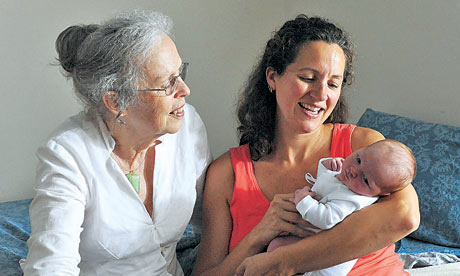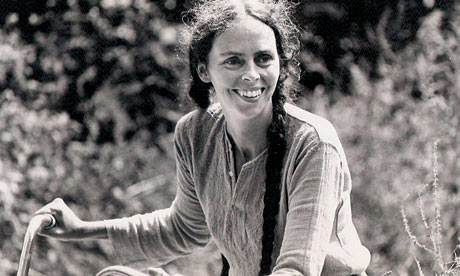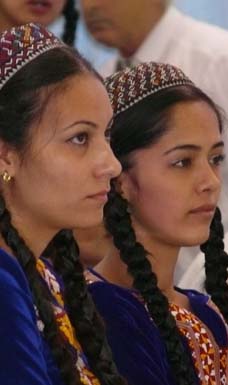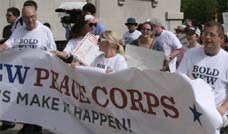
A graduate from the English faculty of the University of Iowa, Ina May became a midwife by default. At the age of 30, following a few years as a volunteer in the Peace Corps, she was travelling with the convoy that was eventually to settle at the Farm. As one of the few women (most in their late teens and early 20s) who already had a child, she attended her first birth – somewhat reluctantly – on board a bus in 1970. Weeks later, two more babies were born in a truckers' garage in Wyoming. It was -20C outside. At first she struggled with the idea of becoming "the midwife", but then accepted it was her vocation. "I had to learn not to let anyone push me around, to be brave and to say things I knew might make people mad."
Malaysia RPCV Ina May Gaskin now sees her early life as having led her towards midwifery
The beatnik turned natural birth expert
Viv Groskop meets a 'far-out' midwife who has become a guru to celebrities. But is delivering a breech baby feet first without pain relief really a good idea?
The Guardian, Saturday 26 September 2009
Caption: Ina May Gaskin, an outspoken advocate for natural childbirth since the 60s, with Bonnie Read and her newborn daughter Margaret. Reed's son, Truman, was also born on Gaskin's commune, The Farm. Photograph: David McClister
Ina May Gaskin drives cautiously round the winding dirt tracks of the Farm, an eco-community buried deep in a 100-acre backwood south of Nashville. She slows down to wave to a young woman with her two children: "Both those were born at home," she murmurs, "as was the mother." A deer ambles across the road. Every so often, a clearing reveals a ramshackle house with a rusting 70s school bus in the driveway. We overtake a large, bearded teenager on a bicycle. "That guy just fell into my hands," she chuckles. "He was enormous."
A closed community of 300 people, the Farm was founded in 1970 by a group of idealistic beatniks who travelled here in convoy from San Francisco. It's now the closest thing to the last hippy commune on earth. For four decades, it has been Ina May's domain. Revered as one of the world's most knowledgable experts on natural birth, she has delivered most of the Farm's current inhabitants and seen more than 2,000 births. Her experience is unique. Because the Farm is relatively cut-off from civilisation, Ina May has the knowledge and experience of a midwife working hundreds of years ago. Some might call her methods primitive or even brutal – they're certainly hippyish. But to her fans, she's just helping women do what comes naturally.
A big noise in the natural birth movement since the mid-70s, suddenly, at 69, Ina May is becoming a household name. The talkshow host Ricki Lake featured her in the campaigning homebirth documentary The Business Of Being Born. Actor Isla Fisher and TV presenter Davina McCall have pronounced themselves fans of her first bestselling book, Spiritual Midwifery, a charming 1977 tome that is as much a historical document ("Birth is far-out!") as a guide to childbirth. She is the only midwife – and only woman – in history to have an obstetric technique named after her, the Gaskin manoeuvre (moving on to all fours to release the baby's shoulders). Her new book, Ina May's Guide To Breastfeeding, is a collection of advice and anecdotes described by the US's bestselling health writer, Dr Christiane Northrup, as "the best thing ever written on the subject".
Speaking from Los Angeles, Ricki Lake enthuses, "Ina May is my inspiration and my hero. When I was newly pregnant with my first son, I happened to read Spiritual Midwifery. The book is very dated, but it's what inspired me to want a natural birth. Her passion is infectious." It turns out celebrity status could have come a lot quicker. In 1988, Ina May had a call from one Demi Moore, then pregnant with her first child, Rumer. Moore wanted to send a helicopter as soon as she went into labour. But Ina May didn't want to attend anyone who wouldn't come to the Farm. "And I didn't really know who she was." She shrugs.
Hollywood is a world away from Ina May's existence – she and her husband, Stephen, now 74, live in a basic but cosy log cabin. When she wrote Spiritual Midwifery, it was full of hippies describing how "psychedelic" and "trippy" their wives looked in labour: "It does a man good to see his lady being brave while she has their baby – it inspires him." When I meet Stephen, himself the author of cult bestseller Hey Beatnik!, he hands me a book of pictures of the original Farm: Cat Stevens lookalikes with long, flowing hair and huge beards tending the crops, women in flowery kaftans breastfeeding their babies, unkempt children making their way to school through fields. Looks like you got to live your Utopian dream, I say. Stephen laughs: "Utopia means nowhere. The Farm has a zip code."
"It looks like fun," Ina May says, "and it almost always was. You didn't need to watch a soap opera: there was one happening all around you."
Wearing a purple wrap top, jade necklace and tiny glasses, Ina May's face is framed by wisps of grey hair. She recently cut it for the first time since 1968 (it used to be down to her thighs and she often wore it in Princess Leia braids). She wears the slightest slick of pink frosted lipstick, a new addition since she watched herself in the Ricki Lake documentary. "At my age you have to do what you can," she laughs, "although there's no way I'm ever dyeing my hair."

Ina May Gaskin in the late 70s, on the commune she set up with her husband Photograph: Ina May Gaskin
We sit and talk over homemade zucchini bread and tea. In their heyday, Ina May says, the Farm's community swelled to 1,200 people and her team of midwives handled around 30 births a month. Now it has eased back to 10, many from the large Amish community in the surrounding countryside. Outsiders come from all over the world – most recently from Ireland and Singapore – to have their babies. (The Irish woman, a surgeon and an Elvis fan, made a last-minute pilgrimage to nearby Graceland before having her baby a few days later.)
A private delivery here costs $3,500 with $300 a week for accommodation. You pay extra, of course, if you end up going into hospital in Columbia, a half-hour drive away, but with Ina May's statistics – a 95% homebirth rate – that's unlikely. Even more impressively, many of the births she has handled are usually regarded as high risk and not recommended outside hospital: more than 20 sets of twins, several hundred births by women who have had more than five pregnancies (most of them Amish) and more than 90 breech births, including several feet first. All delivered naturally with no pain relief and no complications.
It's worth noting, however, that her team has effectively worked in a cultural vacuum: all the mothers she has treated are a self-selecting group, committed to natural birth. The Farm is popular with middle-class American mothers who like to do things holistically. In some states, homebirth is illegal. In others midwives struggle to find hospital jobs; 24 states do not even recognise midwifery as a practice. All of this has contributed to a 30% caesarean section rate (compared with 24% in the UK). "It has moved to assembly line production." Ina May sighs. "Most births in the US now happen between 9am and 5pm, Monday to Friday." She adds that there is no postnatal care in any state; no required visits by midwife or health visitor. Ina May is not confident that the changes Obama is pushing for will help: "We don't have a health ministry. And the insurance companies have an insatiable appetite."
Bonnie Reed, 37, a teacher from Bowling Green, Kentucky, a two-hour drive away, came here to have Margaret, her second child, now five days old. "Yes, with a natural birth you have a lot of intense sensations," she laughs, "but it's over instantly." This is her second birth on the Farm: Truman, two, was also born here and he, like dozens of other babies, has his footprint on the wall of the birthing room in a log cabin in the forest. Reed once worked as a birthing advocate in New York for four years, helping women to get the "natural" birth they wanted in a hospital setting, and has seen first-hand that it's virtually impossible. In her home state, she says labouring women are shaved and given enemas as soon as they arrive at hospital, and homebirth is not legal, so if she had stayed at home, she would have had to find a midwife willing to operate outside the law. "That's the sad part. I had to travel two and a half hours to get the birth I wanted."
Ironically, the cost of going outside the system is far less than she would have paid had she gone into hospital: $10,000 for a vaginal birth, Reed says, and up to double that for a C-section. (Obviously, your insurance – if you had it – might cover some or even all of that.) "I don't understand why they don't encourage midwifery," she adds. "It's less expensive."
Ina May agrees, of course. She had her first baby in hospital in the late 60s and says it was a terrible experience. "I was offended by what happened [she was given anaesthesia without her consent], then they expected me to pay for it! I was so pissed off."
A graduate from the English faculty of the University of Iowa, Ina May became a midwife by default. At the age of 30, following a few years as a volunteer in the Peace Corps, she was travelling with the convoy that was eventually to settle at the Farm. As one of the few women (most in their late teens and early 20s) who already had a child, she attended her first birth – somewhat reluctantly – on board a bus in 1970. Weeks later, two more babies were born in a truckers' garage in Wyoming. It was -20C outside. At first she struggled with the idea of becoming "the midwife", but then accepted it was her vocation. "I had to learn not to let anyone push me around, to be brave and to say things I knew might make people mad."
Ina May now sees her early life as having led her towards midwifery. Her father, Talford, grew up on a farm in Iowa that was lost to the bank during the Depression. He later became a salesman, but Ina May grew up around farming and was close to a grandmother (her namesake) who ran an orphanage. Her mother, Ruth, taught home economics. Ina May had an older brother and two younger sisters. The brother died in a freak gun accident at the age of 15: it taught her compassion and the importance of grieving, she says.
She got married in 1959, aged 19, to an arts student. "I didn't know how to say no and I didn't want to hurt his feelings." The two of them went to Malaysia with the Peace Corps. She became a hippy late, she jokes, at 28. Two years later she met Stephen through her first husband when they were in San Francisco. There, Stephen was running his legendary Monday Night Class where he drew crowds of 1,500 students wanting to share his philosophy of peace and spirituality. This was the era of free love and, as Ina May puts it, "We were two couples together for a while. Things got very complicated. It was about challenging norms. I don't like to talk about it because I don't want to be defined by it." She and Stephen soon ended up together, and she set off on the road with him, with her toddler daughter in tow.
Within a year, the pair had become the focus of the Farm community: Stephen was the unofficial guru, Ina May the community's midwife, pouring her own experience into her bedside manner – in the early 70s she had two miscarriages and a premature baby who died. Much later, her eldest child, Sydney, died from a brain tumour just after her 20th birthday. Her surviving children are Eva Marie, 37, a teacher, Samuel, 35, a personal trainer, and Paul, 34, a web designer – all were delivered on the Farm. She has six grandchildren.
Some of the farm's birthing ethos is harsh: in Spiritual Midwifery, there is an extraordinary scene where a woman giving birth to a stillborn baby is told off by a Farm midwife (not Ina May) for being "complainy". The mother takes it as good advice and stops moaning. Despite her passion, Ina May says she would never talk any woman into a homebirth. "But we do think that hospital birth could be informed by what we learn at home." The Farm's C-section rate remains at a tiny 1.4%. Ina May's techniques ensure that almost two-thirds of the women she delivers keep their perineum intact. She notes in her figures from 1970 to 2000 that, out of 2,028 births, eight babies were lost. This number includes the Farm's first infant death, Ina May's own premature son who had a rare heart condition: "I felt grateful it was me and not another mother." Other babies were stillborn or too premature. But she says she has never lost a baby due to the birth being at home.
The maternal mortality rate in 39 years is zero. During a Farm birth, you apparently do not experience pain, you have "interesting sensations to which you must pay full attention". You do not have contractions, you have "rushes". In all her years of midwifery, Ina May has only ever known one woman who couldn't cope (there is no pain medication at the Farm, not even gas and air) and was taken to hospital at her own request. "We use a lot of tricks," she says. "We tell stories, we keep calm, we prepare the woman for how she's going to feel. Sometimes humour – even if it's gallows humour – is what works best. It's good to laugh at times that feel inappropriate."
Ina May's no-nonsense attitude stands in opposition to the culture of fear that surrounds non-medicalised birth in the US. She has an interesting theory about this. In 1900, half of all US households lived on farms. Now only 1% live on the land. "It makes it easier to dupe people. They don't know animal behaviour and they have no basic understanding of birthing processes or of nature." Her latest campaign is for increased awareness of maternal death: there has been no improvement in maternal death rates in the US since the 80s. Rather, statistics show the rate has increased, from 7.5 deaths per 100,000 live births in 1982 to 11 in 2005 – and the US Centers for Disease Control and Prevention believe the true figure could in reality be as much as three times higher than that reported.
Several years ago, Ina May founded the Safe Motherhood Quilt Project (a giant quilt featuring the names of women who have died in childbirth, most from complications following C-sections and inductions) and is building up her own bank of statistics. "I started to add the names of women who had died. It looked to me like we weren't counting carefully, like we weren't even trying. It might be possible that now a C-section here is actually more dangerous than in, say, the UK. Meanwhile, internationally, people are unwittingly copying the worst model for obstetrics in the world."
As her work on maternal mortality gathers pace, there is an increasing sense of urgency. Ina May will be 70 next year and her husband Stephen, recovering from several eye operations, is physically frail, though as charismatic as ever. Despite the efforts of a few celebrity mothers, homebirth remains an alternative experience, especially in the US. She worries that things are getting worse for women, not better. "We are seeing whole populations moving towards, 'Cut me open.' They don't realise that abdominal surgery can be dangerous. It's a lack of confidence in the idea that the body could have been made right and that it is possible to give birth without horrific injury."
Things are so desperate, she says, that she has taken to juggling with plastic turds on her international lecture tours to try to make people feel more at ease with talking about bodily fluids and internal processes. "Why are women so afraid of poop?" Ina May sighs, as she packs her bag for another check-up. There's one consolation, at least. "I dreaded having a boring life when I grew up. And I certainly can't complain about being bored."
• Ina May's Guide To Breastfeeding is published on 1 October by Pinter & Martin at £11.99. To order a copy for £10.99 (incl UK mainland p&p), go to guardian.co.uk/bookshop or call 0330 333 6846.












